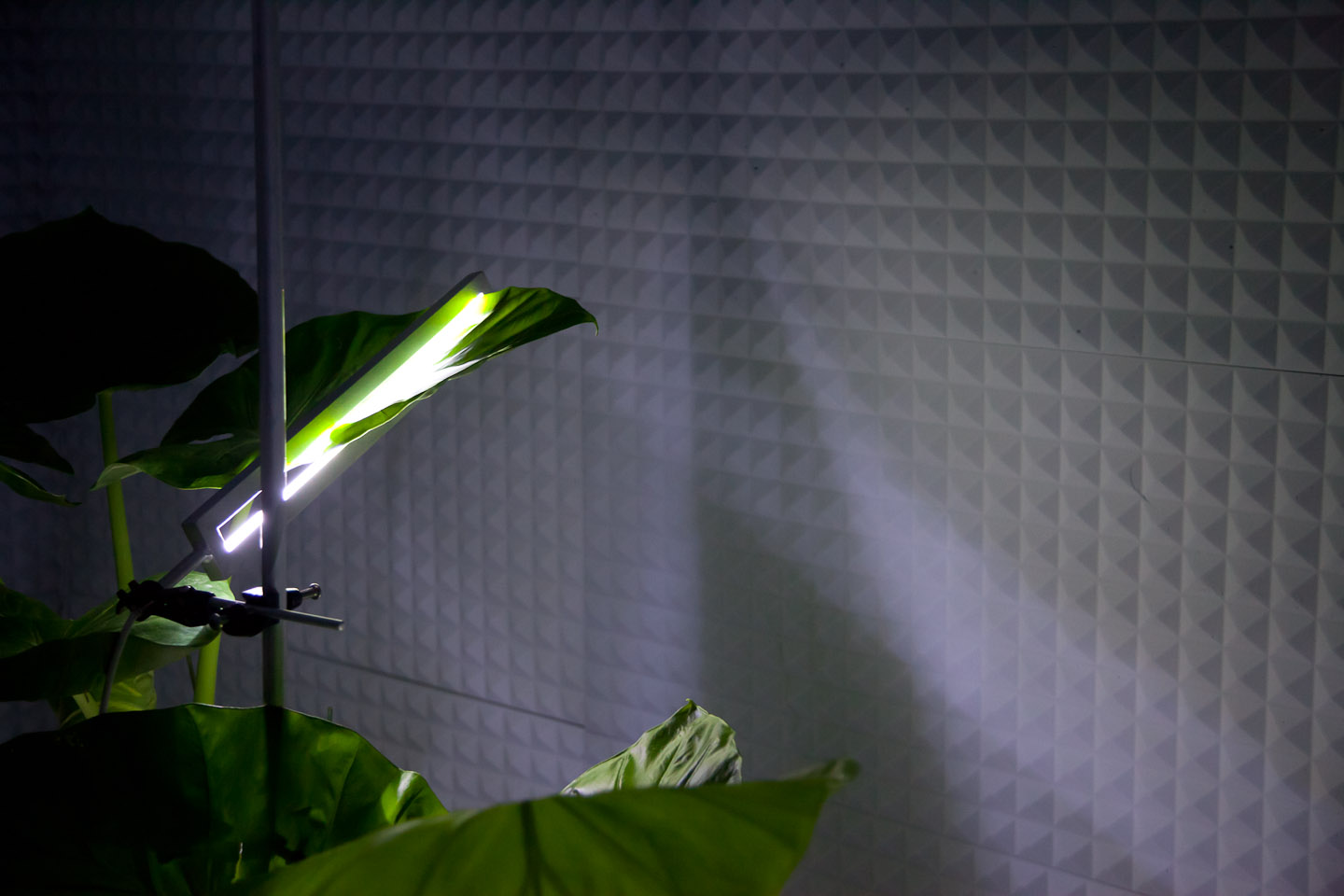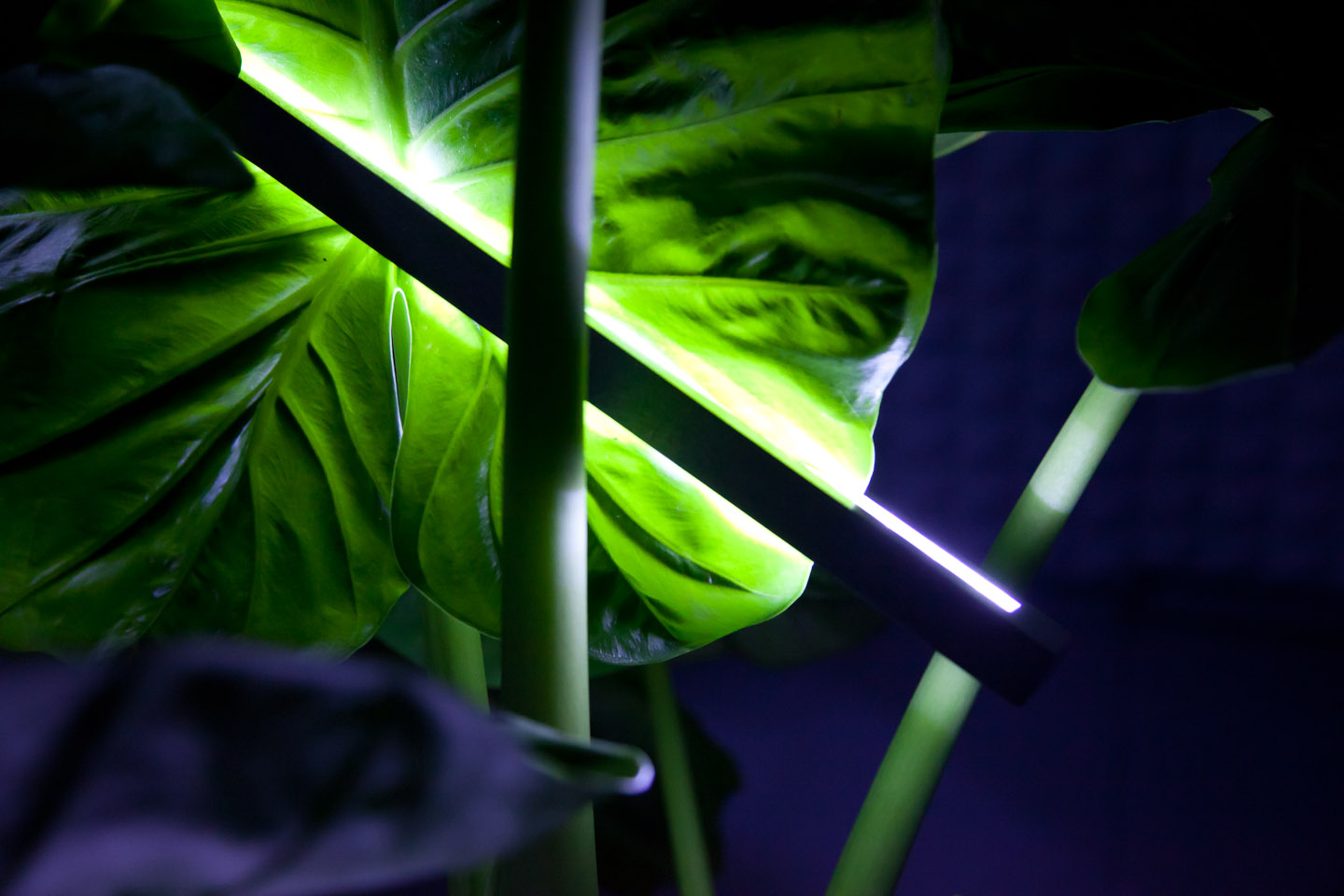The Invisible Aesthetics of Perception
by Keren Goldberg
I enter a small, dark room, and discover a weird mechanism, composed of tropical plants, lights, and unfamiliar meteorological instruments. This machine is meant to enhance the elusive feeling of the ‘quiet before the storm’. It is indeed quiet, only the gentle sound of a humidifier can be heard, but I am not sure whether I am actually sensing something in the air, or just wanting to feel it.
The installation, called ‘The Quiet’, is the result of artist duo Revital Cohen and Tuur Van Balen’s intensive research of this natural, scientific, cultural and historical phenomenon, the ‘quiet before the storm’. They have tried to simulate its invisible conditions: a cold daylight, low temperature, high humidity levels, electromagnetic waves at a specific frequency, high levels of VOC (volatile organic compounds), which are artificially emitted here through the exposure of the tropical plants to daylight LEDs; and finally, increased levels of positive ions, which are believed to cause the negative feeling present when a storm is approaching.
‘Believed’ is a key word in this project. Together with all these supposedly scientific variants, Cohen and Van Balen have also included some folkloric artefacts, which are culturally related to this romantic phenomenon. Hanging in the centre are two storm glasses, specially designed in the early 19th century to predict upcoming storms. Another barometer is made of shark liver oil, which apparently becomes murky in the face of an approaching storm. These small bottles can still be found hanging on balconies in Bermuda.
These varied compounds seem as if part of a mechanical construction, but they do not derive their meaning from a bigger totality, simply because such a totality is missing. The quiet before the storm is stretched between the scientific and the mystical, in a similar manner to the entire field of meteorology, where the boundary between science and folklore is blurred (meteorology as a science was developed in the 19th century, based on subjective fishermen’s observations). The quiet before the storm is a subjective feeling as much as it is a natural effect. However, when one believes, one has no need in understanding. During the quiet moments before a storm, the supernatural becomes the natural. The attempt itself to replicate a semi-scientific mythos is absurd, and Cohen and Van Balen are aware of this difficulty. ‘The Quiet’ is also humorous and self-reflexive in its so-called scientific trial to create wild pre-storm conditions in a tiny closed room.
In investigating this connection between the supernatural and natural, Cohen and Van Balen consulted not just meteorologists, but also pain specialists. It is believed that the conditions of the quiet before the storm heighten pain, which is not surprising, considering the influence the weather has on our health and body. Pain, just as the sensation of the quiet before the storm, is undefined, amorphous and improvable. Moreover, it relates to another aspect of this phenomenon, which is the linguistic one. The quiet before the storm is not just a meteorological-mystical situation, but also a cultural-social paradigm: before the disaster comes, before the pain is inflected, everything seems peaceful and right.
The heightened feeling of pain is part of a physical form of knowledge or presence, a moment of connection to the earth, plants, the atmosphere and universe. It is commonly known that animals can predict natural disasters and are more sensitive to the conditions before a storm. Birds cease to tweet and dogs run to find shelter. In sharing this sensitivity with the animals in the moments before the storm, the human being is becoming animal. When speaking on their concept of ‘becoming animal’, the French philosophers Gilles Deleuze and Félix Guattari mention that a specific factor is necessary in order to communicate the process of becoming (1). Perhaps this factor is the quiet before the storm, the relation of the animal to nature, through which the human being is becoming animal.
Deleuze and Guattari also mention art, and especially music, in relation to the process of becoming (2). Cohen and Van Balen create the musical score of quiet, of silence, which is also, like pain, a relative construct. Their work of art is a machine, a real working operation in space. But this machine does not produce any tactile, functional product. On the contrary, the only thing it produces is quiet, the negation of an occurrence.
Art history is famously paved with various attempts to represent the natural world around us, and many contemporary artists have tried to simulate natural phenomena. Olafur Eliasson, for example, is known for his artistic-scientific investigations of light, water, reflections, the horizon and gravity. However, these works, even when they involve some elements of magic or mystery, always refer back to concrete natural processes, or proven scientific phenomena. In ‘The Quiet’, the work of art becomes a feeling, and no one knows if it even exists in real life, let alone in the artistic cage of representation.
In ‘The Quiet’, a new kind of aesthetic relation between object and subject is formed. It is a new way of thinking of Kant’s elusive ‘common sense’, an inherent part of his concept of the aesthetic judgment. Similar to Kant’s process of aesthetic judgment, which is based on a subjective principal but nonetheless holds a universal validity (3), the subject inside ‘The Quiet’ wonders whether his feelings are subjective, or inflected by his environment and shared with all. He becomes hyper aware of his sensations, while constantly checking if the work ‘works’. Whether the work works or not, the viewer perceives nothing but his own perception, and simply becomes aware of that. In this sense, ‘The Quiet’ creates the aesthetics of the invisible, the aesthetics of perception.
**
1. Becoming is an unnatural process of change, in which the elements involved shed their characteristics and wear new forms, through the production of molecules that enter into specific relations of rest and movement, in a zone of proximity. Becoming is always becoming minor, therefore involving an act of de-territorialisation. More in ‘Becoming-Intense, Becoming-Animal, Becoming-Imperceptible…’ in: A Thousand Plateaus: Capitalism and Schizophrenia, Gilles Deleuze and Felix Guattari, trans: Brian Massumi, Continuum, 2004, p.302.
2. Ibid., p.300.
3. Immanuel Kant, Kant’s Critique of Judgment, translated with Introduction and Notes by J.H. Bernard (2nd ed. revised) (London: Macmillan, 1914). 22 February 2015, http://oll.libertyfund.org/titles/1217, clause 22.
> Supported by a Wellcome Trust Arts Award
> Thanks to Ben Ditzen, Hannah Fasching, Doug Parker and Steve Arnold.





